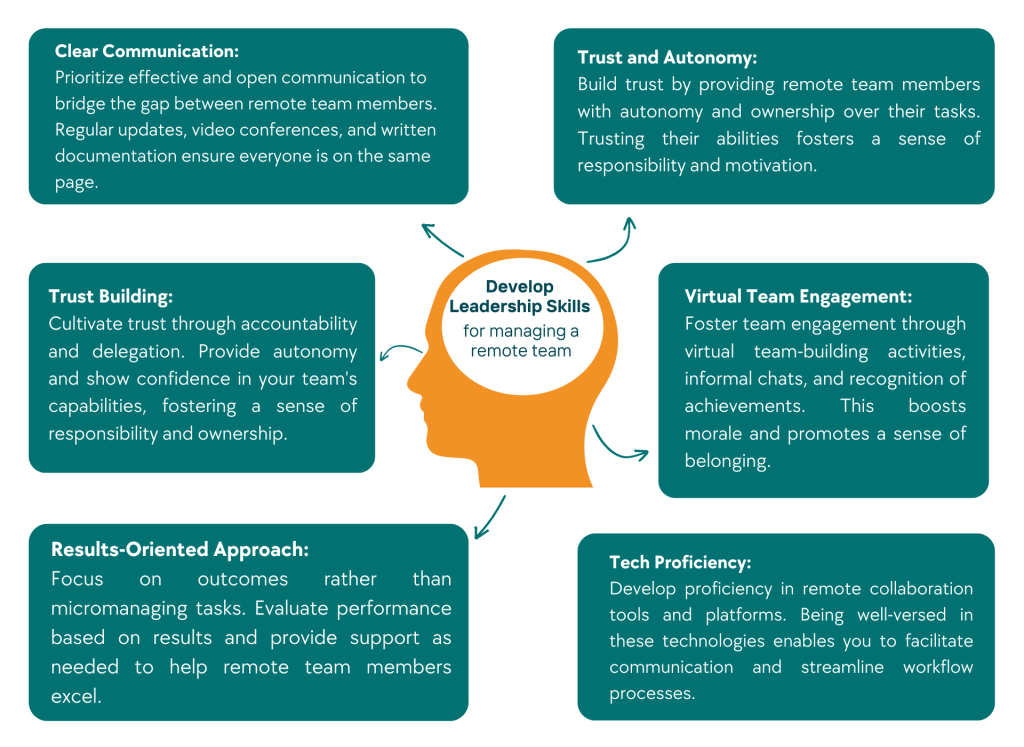The landscape of work has undergone a significant transformation with the advent of remote teams. In the face of technological advancements and evolving work preferences, organizations are increasingly embracing remote work arrangements. This shift has necessitated a reevaluation of traditional leadership practices to effectively manage and lead remote teams.
Managing a remote team presents a unique set of challenges and demands a different approach to leadership. The absence of face-to-face interactions, communication barriers, time zone differences, and the need to foster trust and collaboration from a distance all require leaders to develop specific skills and strategies.
In this blog post, we will explore in-depth the essential elements of developing leadership skills tailored to remote team management. We will delve into the challenges that remote leaders face and provide practical examples and strategies to overcome them. By understanding and embracing these challenges, leaders can develop the necessary skills to successfully guide and inspire their remote teams.
Table of Contents
In the following sections, we will discuss the challenges of remote leadership and provide insights on effective communication, building trust, goal setting, fostering collaboration, embracing flexibility, providing feedback and recognition, and investing in professional development. Each topic will be accompanied by real-world examples to illustrate their practical application.
Managing a remote team requires leaders to navigate the intricacies of virtual work environments while maintaining team cohesion, engagement, and productivity. With the right skills and approaches, leaders can overcome the challenges of remote team management and create a thriving and successful remote work culture.
Let’s embark on this journey to develop leadership skills for managing a remote team, where we will uncover strategies and best practices to excel in this new era of work.
Challenges of Remote Leadership
Managing a remote team brings forth a unique set of challenges that leaders must navigate effectively to ensure team productivity, engagement, and cohesion. Let’s explore some of the key challenges faced by remote leaders:
Communication Barriers
Communication is the backbone of successful teamwork, and remote work introduces new communication challenges. Without face-to-face interactions, non-verbal cues and spontaneous conversations are lost, making it harder to convey tone, intent, and emotions. Miscommunications and misunderstandings can arise more easily in written or digital communication channels.
Lack of Physical Presence
Remote leaders cannot physically observe their team members’ work habits, body language, or daily interactions. This lack of physical presence makes it difficult to gauge individual and team dynamics accurately. It may also hinder the leader’s ability to provide timely guidance, support, and feedback.
Time Zone Differences
Remote teams often span across different time zones, leading to overlapping and non-overlapping work hours. Coordinating meetings, collaboration, and maintaining regular communication becomes a juggling act, and it can be challenging to ensure everyone feels included and valued despite the time differences.
Building Trust
Building trust is crucial for any team, but it becomes even more vital in a remote work setting. Without regular face-to-face interactions, team members may find it harder to develop trust in their remote leader and colleagues. Remote leaders need to proactively establish trust by fostering open communication, demonstrating transparency, and providing support and feedback.
Maintaining Team Cohesion
Remote work can lead to feelings of isolation and disconnection among team members. Building a sense of camaraderie and team spirit becomes more challenging when physical interactions are limited. Remote leaders need to find creative ways to foster collaboration, facilitate virtual team-building activities, and promote a sense of belonging within the team.
Monitoring Performance
Assessing individual and team performance can be more challenging in a remote work environment. Without direct observation, leaders must rely on deliverables, data, and feedback to evaluate performance. Establishing clear goals, implementing performance metrics, and providing regular feedback becomes critical to ensure accountability and productivity.
Overcoming Distractions and Work-Life Balance
Remote work often blurs the boundaries between personal and professional life. Team members may face distractions from family, household chores, or other personal commitments, impacting their focus and productivity. Remote leaders must help their team members establish boundaries, promote work-life balance, and support their overall well-being.
Technological Challenges
Remote work heavily relies on technology, and technical issues can disrupt workflow and productivity. Network connectivity problems, software glitches, or inadequate technology infrastructure can hinder effective communication and collaboration. Remote leaders need to ensure that their team members have the necessary tools, resources, and technical support to carry out their work effectively.
Onboarding and Training
Bringing new team members into a remote team can be challenging. The lack of in-person interactions and informal learning opportunities make it harder for new members to integrate into the team and quickly grasp the team’s dynamics and culture. Remote leaders must provide thorough onboarding processes, virtual training, and ongoing support to help new members feel welcomed and supported.
Managing Conflict
Conflict is inevitable in any team, and remote teams are no exception. However, addressing and resolving conflicts can be more complicated in a remote work environment. Remote leaders must be adept at managing conflicts remotely, facilitating difficult conversations, and finding resolutions that promote team harmony and collaboration.
Before diving into leadership development, it’s essential to grasp the unique challenges posed by managing a remote team. These challenges include communication barriers, lack of face-to-face interaction, time zone differences, and potential feelings of isolation. By recognizing these hurdles, leaders can adapt their strategies to overcome them effectively.
Key Strategies to Develop Leadership Skills for Managing a Remote Team

Developing leadership skills for managing a remote team requires a unique set of strategies to effectively navigate the virtual work environment. Here are some key strategies to consider:
Effective Communication
Communication lies at the heart of successful remote team management. Leaders should prioritize establishing clear and transparent lines of communication. This includes utilizing various communication tools such as video conferencing, instant messaging, and project management software. Regular check-ins, team meetings, and one-on-one sessions help maintain team cohesion and provide a platform for sharing ideas, addressing concerns, and fostering a sense of belonging.
Example: Let’s say you’re leading a remote team of designers working on a website redesign project. To facilitate effective communication, you could schedule weekly video meetings to discuss progress, challenges, and gather feedback. Additionally, you can set up a dedicated channel on a messaging platform where team members can share ideas, ask questions, and provide updates in real-time.
Build Trust
Trust is the foundation of any successful team, and it becomes even more critical in a remote work environment. Leaders must proactively build trust with team members, promoting an environment of psychological safety and mutual respect. Encourage open dialogue, actively listen to team members’ concerns, and be responsive to their needs. Establishing trust helps foster collaboration, boosts morale, and enhances overall team productivity.
Example: To build trust, you can assign team members with clear responsibilities and empower them to make decisions. Avoid micromanaging and instead focus on providing guidance and support. By demonstrating trust in their abilities, you create an environment where individuals feel valued and motivated to contribute their best work.
Goal Setting and Clarity
Setting clear goals and expectations is essential for remote teams. When team members are physically separated, it becomes even more critical to align everyone towards a common purpose. Leaders should define measurable goals, communicate them effectively, and ensure they are understood by each team member. Regularly revisit these goals, provide feedback, and recognize achievements to keep the team motivated and focused.
Example: Consider a remote sales team aiming to increase monthly revenue. As a leader, you can set specific revenue targets for each team member and provide them with the necessary tools and resources to achieve those goals. Regular progress updates, shared dashboards, and performance evaluations can help track individual and team progress, ensuring alignment with the overarching objective.
Foster Collaboration and Team Spirit
While physical proximity fosters collaboration in traditional office settings, remote teams require deliberate efforts to promote collaboration and create a sense of camaraderie. Leaders should encourage cross-functional collaboration, facilitate knowledge sharing, and provide opportunities for team members to connect on a personal level. Virtual team-building activities, such as online games, virtual coffee breaks, or team challenges, can go a long way in fostering team spirit and strengthening relationships.
Example: To encourage collaboration, you could implement a project management platform that allows team members to collaborate on tasks, share files, and provide feedback. Additionally, you can organize virtual brainstorming sessions or use collaborative tools like virtual whiteboards to facilitate idea generation and problem-solving. By fostering a collaborative environment, you create a space where remote team members can feel connected, valued, and motivated to work together towards common goals.
Embrace Flexibility and Adaptability
Remote work offers flexibility in terms of location and work hours. As a leader, it’s important to embrace this flexibility and promote a healthy work-life balance for your team members. Encourage open discussions about individual preferences and constraints, and be flexible in accommodating them whenever possible. Acknowledge and respect different time zones, cultural backgrounds, and personal circumstances to create an inclusive work environment.
Example: Let’s say you have a remote team spread across different continents. Instead of imposing rigid working hours, you can establish core hours when team members need to be available for meetings or collaboration. Beyond those core hours, allow team members to structure their work schedules based on their personal productivity patterns and time zone constraints. This flexibility promotes work-life balance and enhances overall job satisfaction.
Provide Continuous Feedback and Recognition
Feedback plays a crucial role in the growth and development of remote team members. Regularly provide constructive feedback, both on an individual and team level, to help them improve their skills and performance. Recognize and celebrate achievements and milestones to boost morale and create a positive work environment. Remote team members often crave feedback due to the lack of in-person interactions, so providing timely and specific feedback is crucial.
Example: Incorporate feedback into your team’s regular communication channels. For instance, you can allocate time during team meetings to discuss individual progress, provide constructive feedback, and highlight achievements. Additionally, implement a recognition program that publicly acknowledges team members’ contributions, whether through an internal newsletter, a dedicated channel, or a virtual ceremony.
Invest in Professional Development
Leadership skills are not innate but can be developed and enhanced over time. As a remote team leader, invest in your own professional development and encourage team members to do the same. Offer resources, training programs, and mentorship opportunities to support their growth. By prioritizing continuous learning and skill development, you create a culture of growth within your remote team.
Example: Consider organizing virtual workshops or webinars on relevant topics such as remote leadership, effective communication, or project management. Encourage team members to attend conferences, join professional networks, or participate in online courses to enhance their skills. Supporting their professional development not only benefits individual team members but also contributes to the overall success of the team.
Encourage Autonomy and Empowerment
Remote work provides an opportunity for team members to take ownership of their work and make decisions independently. Remote leaders should foster a culture of autonomy by setting clear expectations, providing guidelines, and then empowering team members to take responsibility for their tasks. This autonomy not only boosts individual motivation and engagement but also enhances overall team performance.
Example: Instead of micromanaging every aspect of a project, give team members the freedom to plan and execute their work. Provide them with the necessary resources and support, and trust them to deliver quality results. This autonomy promotes accountability and empowers team members to showcase their skills and expertise.
Foster Virtual Social Connections
Remote work can be isolating, and building social connections among team members becomes essential to maintain a sense of belonging and collaboration. As a remote leader, encourage informal interactions and create opportunities for team members to connect on a personal level. This could include virtual coffee breaks, team-building activities, or even non-work-related chat channels.
Example: Plan virtual social events such as online team lunches, happy hours, or games where team members can relax and engage in casual conversations. These activities foster a sense of camaraderie and strengthen the team’s bond, even when physically separated.
Adapt Communication Styles
Effective communication is vital for remote team success. However, different team members may have different communication preferences or styles. Remote leaders should be adaptable and take into account individual communication preferences to ensure messages are received and understood effectively.
Example: Some team members may prefer written communication, while others may prefer video calls or voice messages. As a leader, adapt your communication style to meet the needs of each team member. Be open to different communication channels and encourage team members to express their preferences.
Develop Virtual Leadership Presence
In the absence of physical presence, remote leaders must develop a strong virtual leadership presence. This includes being responsive, available, and visible to team members. Regularly communicate with the team, provide updates, and be proactive in addressing questions or concerns. Building a strong virtual leadership presence helps instill confidence and trust within the team.
Example: Schedule regular team meetings or check-ins to provide updates, address challenges, and gather feedback. Be prompt in responding to emails or messages, and ensure team members feel supported and heard. Your virtual leadership presence sets the tone for the team’s engagement and commitment.
Cultivate Cultural Intelligence
Remote teams often consist of members from diverse cultural backgrounds. As a leader, it is crucial to cultivate cultural intelligence and sensitivity to effectively manage and collaborate with team members from different cultures. Understand and respect cultural differences in communication styles, work habits, and decision-making processes.
Example: Take the time to learn about different cultures represented within your remote team. Consider incorporating cultural awareness training or providing resources to team members to increase understanding and foster a culture of inclusivity.
Summary
In the ever-evolving landscape of remote work, developing leadership skills specifically tailored for managing a remote team is crucial for success. Throughout this blog post, we have explored the various challenges faced by remote leaders and provided strategies and examples to help overcome them.
Effective communication lies at the core of remote team management. Leaders must establish clear and transparent communication channels, adapt their communication styles to meet individual preferences, and foster a sense of connection and collaboration among team members. Building trust is another essential aspect, requiring leaders to demonstrate transparency, provide support and feedback, and empower team members to take ownership of their work.
Setting clear goals, promoting autonomy, and fostering a sense of teamwork and collaboration are vital for remote team success. Leaders should invest in virtual team-building activities, encourage social connections, and facilitate knowledge sharing to foster a strong sense of belonging and camaraderie among team members.
Flexibility and adaptability are key characteristics of successful remote leaders. They must embrace the unique challenges posed by remote work, such as time zone differences and work-life balance, and find ways to accommodate individual preferences and constraints. Providing continuous feedback and recognition helps motivate and engage team members while investing in their professional development cultivates a culture of growth and learning.
In conclusion, developing leadership skills for managing a remote team requires a proactive and adaptable approach. By understanding and addressing the challenges of remote leadership, incorporating effective communication strategies, fostering trust and collaboration, promoting autonomy, embracing flexibility, and investing in professional development, leaders can navigate the complexities of remote team management and guide their teams toward success.
As remote work continues to shape the future of work, leaders who can master these skills and adapt to the changing dynamics will be well-positioned to lead their remote teams to achieve their goals and thrive in the digital age.




